|
|
|
|
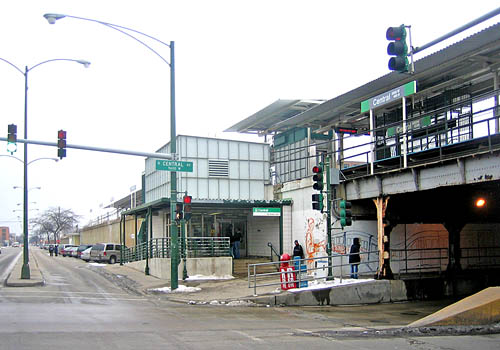 Central station, significantly renovated in 1994-96 with a new station entrance and elevator added to the platform, is seen looking west on February 28, 2007. For a larger view, click here. (Photo by Graham Garfield) |
|
|
|
|
 Central station, significantly renovated in 1994-96 with a new station entrance and elevator added to the platform, is seen looking west on February 28, 2007. For a larger view, click here. (Photo by Graham Garfield) |
Central
(5600W/400N)
Central Avenue and
Corcoran Place, Austin
Service Notes:
Green Line: Lake
Accessible Station
Quick Facts:
Address: 350 N. Central Avenue
Established: April 19, 1899
Original Line: Lake Street Elevated Railroad
Previous Names: none
Rebuilt: 1962, 1994-96 (renovation)
Skip-Stop Type:
Station
Status: In Use
History:
Original Ground-Level Station
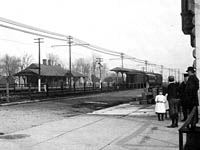
A three-car Loop-bound train is berthed at the ground-level Central Avenue station, looking northeast from Parkside Avenue on November 20, 1899. The large building on the left is the C&NW's adjacent depot. For a larger view, click here. (Photo from CTA Collection) |
The first Central station was built as part of the Lake Street Elevated's 1899 extension west from Laramie Avenue into Cicero Township and what is now the suburban of Oak Park. After leaving Laramie the line descended from the elevated structure down to ground level and continued to the terminal at-grade. Central was the first station along this at-grade extension. The "L" was powered by overhead trolley wire along the extension for safety purposes due to the grade-level running. The tracks also paralleled the adjacent Chicago & North Western Railroad.
The modest stations on this portion consisted of island stations and platforms constructed of wood. The narrow station houses with their clapboard paneling and peaked roofs with overhanging eaves emptied out onto an island platform covered by a peaked canopy that was actually a continuation of the station house's roof. The tall steel poles that carried the "L"'s overhead wires occasionally poked through the canopy, interrupting the platform.
The "L"'s street-level operation began to result a number of crossing accidents, typically due to pedestrians and wagon drivers failing to take note of approaching trains. Neither the "L" nor the C&NW had any type of crossing protection originally. Manually-operated crossing gates and gatemen helped reduce accidents but did not eliminate them. The problem got worse as automobile traffic entered the picture and became more prevalent. The situation was further exacerbated when the parallel C&NW elevated their right-of-way circa 1908-09, creating a blind intersection due to the embankment preventing southbound traffic from seeing approaching "L" trains until they were on the crossing. The Chicago and Oak Park municipal governments tried for decades to get the "L" to elevated their tracks west of Laramie Avenue, to no avail.
Track Elevation
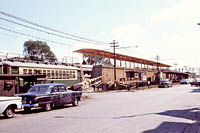
The new Central station is under construction on the embankment above in this 1962 view looking northeast from Parkside and Lake as an inbound 4000-series train approaches the old Central station. Note that a section of the embankment has been removed for the construction of the Parkside entrance to the new facility. For a larger view, click here. (Photo from the IRM Collection, courtesy of Peter Vesic) |
Finally, in 1961 construction began on a joint project to elevate the Lake Street "L" tracks. The $4 million project was jointed financed by the Chicago Transit Authority (who had assumed operation of the "L" in 1947), City of Chicago, Village of Oak Park, Cook County, State of Illinois, and US Bureau of Public Roads, and in cooperation with the Chicago & North Western Railroad. Rather than build a new elevated structure for the "L", the rapid transit tracks were relocated onto the C&NW's embankment, occupying the southern portion of the elevated right-of-way, which the railroad vacated. The elevation project eliminated 22 grade crossings between Laramie and Harlem avenues.
The elevation project included the construction of new stations and removal of the old wooden stations at street-level. The stations included new island platforms on the embankment and street-level station houses on the south side of the embankment. The stations were very modern for the time, and described thusly in a promotional brochure for the project:
Integrated with the south wall of the North Western embankment, the new stations incorporate many design features.
Large picture windows enhance a light and bright interior. External walls are of ceramic glazed brick in the color code for the respective station. The color is repeated in porcelain enamel panels of each station front, in the glazed ceramic tile of the interior walls, and in the porcelain enamel panels of the agents' booths.
Electric signs over the entrance of each station buildings are to identify the station and display the travel time between the station and Chicago's Loop.
Passenger control facilities include agent-controlled, illuminated fare indicator turnstiles, coin-operated turnstiles, and electrically-operated, remotely-controlled exit turnstiles.
In the metal platform canopies, which extend over the roofs of cars at train stops protecting boarding and alighting passengers from rain, sleet and snow, the station color code is repeated. Translucent fiberglass panels are interspersed with the metal panels of the canopies.
Platforms and stations are illuminated by fluorescent luminaires.
At the platforms, the lights are turned off ad on automatically by photo-electric cells. Lighting in the stations is controlled by the agents.
The "color code" for Central station, used for various accents in the facility, was yellow. The tiled wall outside the station entrances, on the embankment, featured pin-mounted metal letters spelling out the name of the station entrance.
The Central station had two entrances, with one at Central Avenue at the east end of the station and another at the west end of the station at Parkside Avenue. As a result, the station was sometimes referred to as "Central-Parkside" in some promotional materials, though maps and signage simply referred to the station at "Central".
The station entrances at Central, Austin and Oak Park were equipped with an escalator in addition to the stairs to access the platform. The escalators were of a reversible, dual-operation type. Typically, in rush hours the escalators operated in the peak direction (up in the morning, down in the evening) and in off-peak hours operated automatically. While in automatic mode, the escalator was activated by treadle steps, at the top and at the bottom. Once set in motion by a passenger, it operated in the proper direction until the passenger had alighted. Flashing signs warned patrons not to board an escalator operating in the wrong direction. Both the escalators and stairs were protected by glass-walled shelters at the platform level.
The platform features a wooden floor and a steel canopy supported by I-beams. The platform lights outside the canopy were unusual, found only at the 1962 Lake Street Elevation stations, with a thin pole and a conical head with a convex saucer as a cap.
Lake "L" trains began using the new elevated right-of-way on the C&NW embankment between Laramie and Harlem on Sunday, October 28, 1962. The ground-level stations closed and the elevated platforms opened, but the new permanent street-level station houses were not ready yet, due to the street-level tracks needing to be removed before they could be completed. Thus, on opening day, temporary fare control areas were used at Central and Parkside. Completion of the remaining amenities was not far off, however. The escalator at Central went into service on Friday, November 2, 1962. The station's two permanent station houses went into service on Friday, January 11, 1963.
The station saw modest changes through the following years. On Saturday, January 13, 1973, in one of several rounds of cost-cutting that year that included multiple station closures and service reductions, the Parkside entrance to Central station was closed, though it was retained as an exit. Parkside remained available as an exit as least as late as the 1980s, but has since been closed and boarded up.
Green Line Renovation
The Lake Street "L" and the rest of the Green Line closed in 1994 for a two year refurbishment. Central was one of two stations on the 1962 Lake Street Elevation that received some significant improvement work -- the other was Harlem/Lake -- while the three stations in between were largely unimproved during the project.
The station house at Central Avenue was reconstructed, given a larger interior footprint and a ramp up to it for ADA-compliant access. The design of the new headhouse was largely utilitarian, with white tile walls and a glass and aluminum storefront. Metal posts, railings, and canopies were painted green. An elevator was added inside the embankment to provide step-free access to the boarding platform. The new elevator tower features broad, overhanging eaves above the platform canopy that provide both weather protection and an iconic silhouette. The platform was refurnished, with new windbreaks, lighting, signage, benches and other amenities added.
During October 1995, construction crews excavated the retaining walls and embankment to carve out a shaft for an elevator from the street-level station house to the elevated platform.
The Green Line reopened on Sunday, May 12, 1996, but work at Central was not yet completed. The new entrance at Central Avenue was still under construction, so the station opened with temporary access through the old Parkside station entrance. In early December 1996, construction had progressed such that the full platform length at Central was available, but access was still from the Parkside temporary entrance. The new Central Avenue entrance was completed at placed in service at 1000 hours on Monday, December 16, 1996, at which point the station became ADA-accessible. As the completed, permanent station was not intended to have two entrances, the Parkside entrance was once again closed, concurrently with the opening of the new Central Avenue entrance, and boarded up.
Recent Improvements
During Autumn 2004 and Spring 2005, several "L" stations got new station name signs. As part of a multi-station program, twelve facilities in all on the Blue, Purple, Red, Orange, and Green lines received new, Current Graphic Standard station name signs, replacing older KDR-type signs that used an outdated graphic scheme that was inconsistent with the colored line names. The new signs not only replaced old ones in existing locations at these island platform stations, but were added at additional locations outside the tracks, facing to the platform, for ADA compliance.
The new additional signs at Central were installed outside the tracks, mounted on new steel brackets that are supported and project from below. Installation at all stations was complete by the end of November 2004 except at Cicero and Central on the Green Line, whose signs were completed in early 2005. Single tracks were operated on the Green Line through Central during late night and weekend hours in late April and early May 2005 to complete work at that location. Fabrication and installation of the signs was performed by contractor Western Remac.
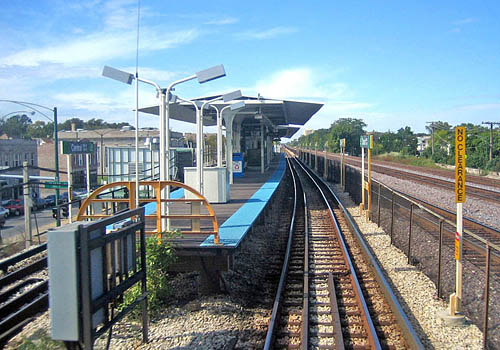 The Central station platform is seen looking west from the motorman's point of view on September 30, 2006. The canopy dates from the 1962 construction of the station, with a section in the middle removed for the elevator added in the 1996 renovation. The "NO CLEARANCE" sign on the right was added when the outboard station name signs were added in 2005, letting operators know not to put their heads or arms out of the motorcab window as they pass the signs. For a larger view, click here. (Photo by Graham Garfield) |
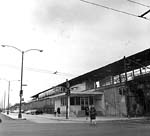 |
central-lake07.jpg
(84k) |
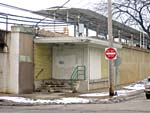 |
central-lake.parkside02.jpg
(171k) |
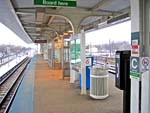 |
central-lake04.jpg
(166k) |
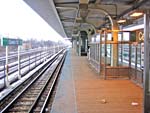 |
central-lake05.jpg
(198k) |
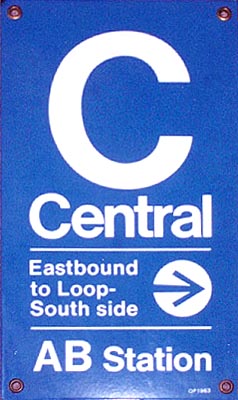
 |
central-lake_signEB.jpg
(33k) |
|
|